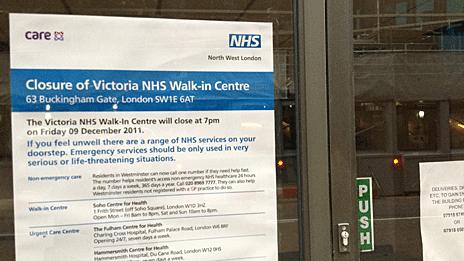Walk-in centre closures 'may worsen A&E crisis'
- Published

Closing walk-in centres may make it harder for people to see GPs - and risks sending more people to A&E, warns healthcare regulator Monitor.
It reviewed the walk-in centre service after the closure of 50 of the 230 in England in the last three years.
Monitor found the centres are popular with the public, but critics fear they can mean duplication of services.
The government said walk-in centres were "one part" of out-of-hours care.
Family GPs, community services and pharmacists all have a part to play, says Health Minister Lord Howe.
But shadow health secretary Andy Burnham said the decision to dismantle walk-in centres was an act of vandalism and that patients were paying the price.
Andy Burnham: "This A&E crisis is of this government's own making"
As part of its review, Monitor surveyed just under 1,900 patients at 20 walk-in centres.
When patients were asked where they would have gone if the walk-in centre had not been available, 21% said they would have gone to A&E, while a third would go to their own or a different GP.
The poll also found 22% had tried to contact a GP practice but found no appointment, or none at a convenient time.
And 24% did not even try to contact a GP because they did not think they would get an appointment.
'Paying twice'
Former Prime Minister Tony Blair announced plans to establish the first walk-in centres in 1999, to provide convenient access to basic primary care services without the need for an appointment.
As their name suggests, patients can 'walk in' and get seen.
Most are GP-led, though some are overseen by nurses.
Private companies, such as Virgin and Care UK, currently run around a sixth of the centres.
The Monitor review found that walk-in centres were more likely to be used by those aged 16-45, with women slightly more likely to attend.
Those that have closed have done so due to concerns they are not helping A&E.
Many contracts for walk-in centres are up for renewal in 2014 and the review found confusion about who should decide on their fate, and said decisions had possibly been put off because of the upheaval in the NHS.
Some commissioners also felt they were "paying twice" for patients, once with the GP they are registered with and a second time for their treatment at the walk-in centre.
But Monitor said there should be careful thought about possible closures.
Catherine Davies, Monitor's executive director of co-operation and competition, said: "We've been told that one in five people would choose to go to an accident and emergency department if the walk-in centre wasn't there for them.
"While it is for commissioners to decide whether to keep a walk-in centre open, we need to make sure that the needs of patients are fully considered before decisions are taken."
The review suggests the payment system to be changed so GPs have more of an incentive to be flexible, providing online or phone consultations, improving receptionist skills, extending hours or offering walk-in appointments.

The London Victoria centre closed in 2011
It comes as the College of Emergency Medicine has warned that more than half of specialist registrar posts in A&E have been left vacant over the past three years, with many doctors moving to other specialities or going abroad.
Downing Street said that David Cameron is getting personally involved in overseeing the NHS's response to expected pressures on hospitals in England this winter.
- Published11 November 2013
- Published31 May 2013
- Published18 August 2013
- Published17 June 2013
- Published28 June 2012